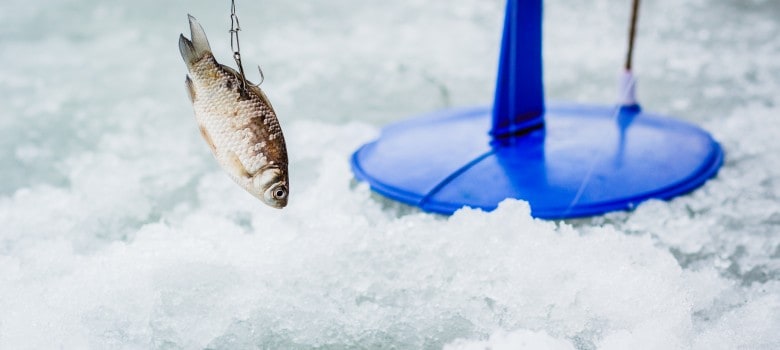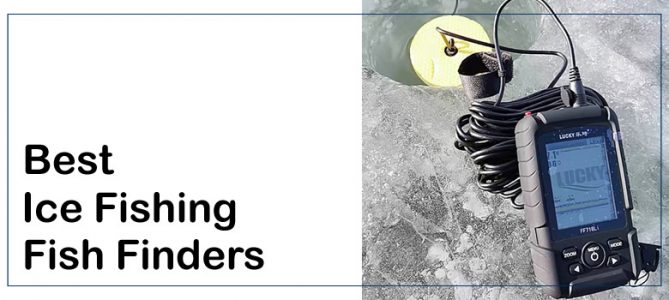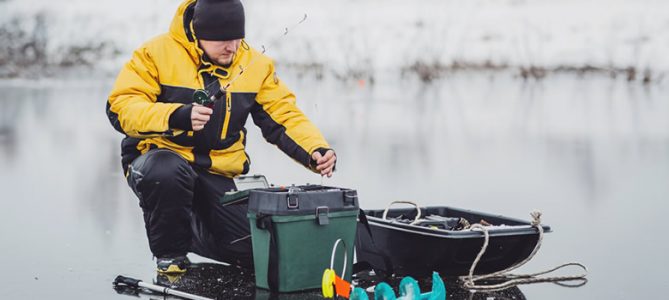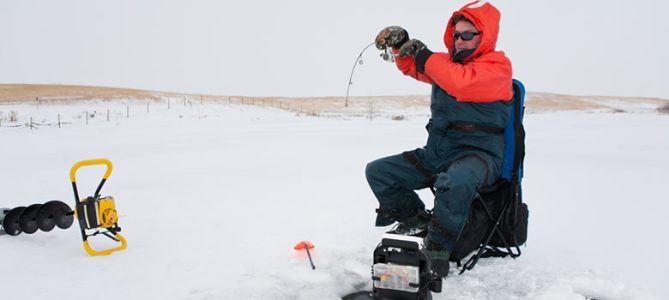If you buy via a link on this page, we may receive a commission, at no extra cost to you.Learn more
Fishing on ice is one of the most demanding forms of angling. It takes the same preparation as regular fishing, with the added difficulty of cold. Among all the things you have to think of, bait is arguably the most important. Here, live bait is king.
It is no surprise when people come here asking what is the best live bait for ice fishing. Typically, minnows, nightcrawlers, mealworms, and spikes are our recommendations.

Having the right bait is just one step. You need to know how to use it as well. Today, we will discuss that and many other things related to living bait and ice fishing. Let’s get right down to it.
Live Minnows
Few things beat live minnows for ice fishing. They are the perfect snack for fish during the freezing winter. The natural movement of live minnows triggers the response of lethargic fish, which is one of the challenges of ice fishing.
But it takes more than searching for live minnows near me to use them effectively for ice fishing. You see, many beginners pierce them in the wrong place, killing them as a result.
That’s why we suggest piercing the minnows in the dorsal fin. This way, they will be able to swim freely and be able to cope with the cold. At least for some time, until it eventually dies. Because now that will happen regardless of what you do. Therefore, you must keep a bucket of fresh minnows in reserve for the occasion.
Some anglers pierce them in the mouth. But I believe that this kills the action. Sadly, action, as we said before, is crucial since fish become lethargic at low temperatures. That’s why I encourage you to pierce them on the dorsal find.
How to Keep Minnows Alive for Ice Fishing
Needless to say, you need to keep minnows alive for as long as you want to fish. For some anglers, this is easier said than done. Luckily for you, we know how.
I usually use a cooler with water at around 20 degrees. The cooler needs to be thick and well-insulated to keep the water inside from freezing or getting too cold for minnows to live. All the better if you have an ice fishing shelter.
I’ve heard that some anglers heat water with propane cylinders. I advise against this as you can instantly kill the minnows while purring the water into the cooler.
Ice Fishing with Nightcrawlers

Many people don’t know that they can use nightcrawlers for ice fishing. Walleye, trout, and even pike can’t resist a thick worm.
If angling with worms is new to you, then keep reading. The most important thing is to use small, thin hooks. Make sure to check our comprehensive guide on hook types and sizes to choose the right one.
The second thing you must know is to pierce them around the midsection. Keep clear of the ends, as one of them is the head. You will kill the worm instantly if you pierce it through the head. Once the nightcrawler is hooked, we suggest wrapping it around the hook. This way, the worm will stay on the hook even after being bitten.
Keeping them alive is usually easier than minnows. Just keep them in the same box from the store. If it is small, you can stash it inside your jacket and keep it warm with your body.
Waxworms
Anglers have been using waxworms for many years now. Some even say that they are better than nightcrawlers for ice fishing. We will leave you to judge which one is better.
The truth is that they are equally effective, as long as you know how to use them, of course. Waxworms are widely available in many tackle shops. Using them is pretty much the same as with night crawlers. The only difference is that they are not large enough to wrap the worm around the hook. On the other hand, you can either pierce them in the middle of the tail, since this time it is easy to distinguish between the head and the tail.
Keep them alive using the same process we described before.
Spikes
Chances are that you don’t know what a spike is if you are new to the ice-fishing world. These maggots are like waxworms but with the thicker exterior. They can remain alive longer as a result. The only disadvantage is that they are not as easy to find and are a little smaller.
Because they are smaller, spikes are ideal for fish such as bluegill and sunfish. However, I’ve managed to catch trout with them too. The trick is to use two or three of them at the same time.
Again, pierce them through the middle and keep them warm inside your jacket.
Mealworms
Mealworms are the primer ice fishing bait when the temperatures start to rise. They are fat and juicy, making them irresistible for trout and panfish alike. Because they are quite sensitive to low temperatures, we recommend protecting them from the cold by placing them near a heater or inside your jacket.
Nevertheless, they will hold long enough inside the water to entice a bite. Just like before, I tend to use two mealworms at the same time.
You can find Mealworms in most fishing tackle shops. But if you don’t, you can also try pet stores, as they are also used as food for reptiles.
Do You Need Live Bait for Ice Fishing?
No. You can perfectly fish on ice using artificial bait. However, since fish become lethargic at low temperatures. We highly recommend using live bait.
You see, live bait has a natural scent and action that will definitely attract fish. It will take some time, sure. But your chances will be higher than using artificial lures.
How Do You Rig Live Bait for Ice Fishing?
Aim for the dorsal fin if you are using minnows. You can also hook them in the mouth or tail. Check this video to learn how.
For worms, pierce them through the middle.
What is The Best Time to Ice Fish?
Although there are no rules for this, I often find myself fishing just after sunrise. At least, these are the most productive hours for me. But I’ve also gotten lucky in the hours prior to sunset.
What is The Best Depth for Ice Fishing?
This question is tricky. It depends on what you are using. For example, if you are using ice fishing tip-ups you typically aim between 2 to 3 feet about the bottom.
Things can be different if you are using a rod and line. Most times, you will be fishing around 6 to 20 feet deep.
Ideally, you want to use a fish finder. This way, you can determine the depth more accurately. If you don’t own a fish finder yet, we invite you to check our selection of the best ice-fishing fish finders money can buy. You can also visit our in-depth guide on how to choose a fish finder here.
Final Thoughts
Ice fishing doesn’t have to be tougher than it already is. All you need to do is equip yourself with the best gear and bait available. In this case, nothing beats live bait.
Minnows, nightcrawlers, mealworms, waxworms, and spikes are the best live baits you can use for ice fishing. The first is, hand down, our favorites. They are widely available and inexpensive. Plus, they are easier to keep alive and use.
But don’t take our word for granted! Try them all and come back to share your story!




